The Law of Negligence: Business Responsibilities, Defenses, and Cases
VerifiedAdded on 2023/05/30
|6
|2235
|324
Report
AI Summary
This report delves into the intricacies of negligence law, focusing on its implications for businesses. It begins by outlining the three essential elements for a successful negligence claim: duty of care, breach of duty, and resulting damages. These elements are illustrated through the analysis of landmark cases such as Donoghue v Stevenson and Barnett v Packer, which establish the concept of duty of care and its extension to various parties. The report further examines the issue of product quality and its relation to negligence liability, contrasting the rulings in Junior Books Ltd v Veitchi Co Ltd and Muirhead v Industrial Tank Specialities Ltd to clarify when a lack of quality constitutes grounds for a negligence claim. Finally, the report explores the defenses available to businesses when faced with negligence claims, providing insights into how businesses can minimize their liability and protect their interests under the law. The report emphasizes the importance of understanding negligence law to mitigate risks and ensure responsible business practices.
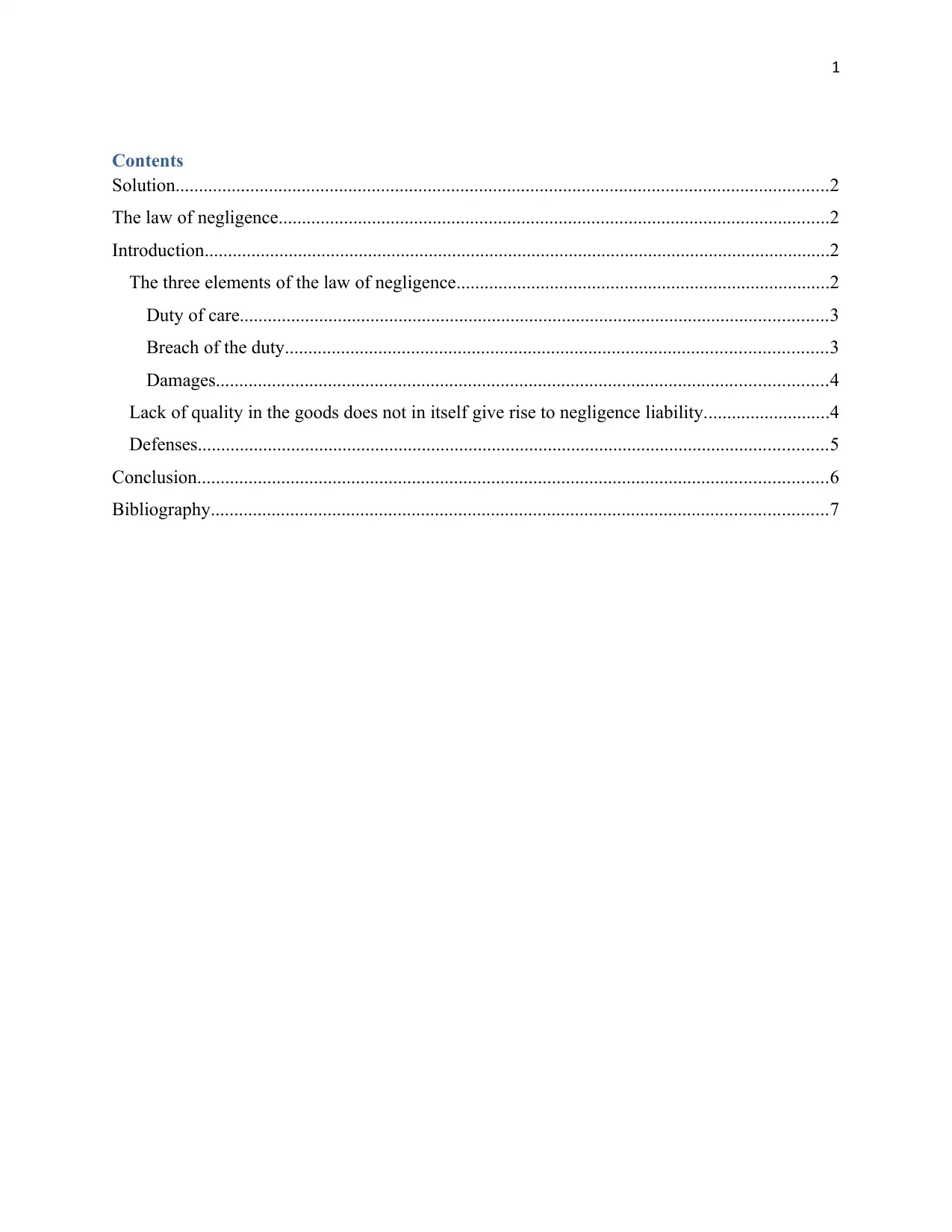
1
Contents
Solution............................................................................................................................................2
The law of negligence......................................................................................................................2
Introduction......................................................................................................................................2
The three elements of the law of negligence................................................................................2
Duty of care..............................................................................................................................3
Breach of the duty....................................................................................................................3
Damages...................................................................................................................................4
Lack of quality in the goods does not in itself give rise to negligence liability...........................4
Defenses.......................................................................................................................................5
Conclusion.......................................................................................................................................6
Bibliography....................................................................................................................................7
Contents
Solution............................................................................................................................................2
The law of negligence......................................................................................................................2
Introduction......................................................................................................................................2
The three elements of the law of negligence................................................................................2
Duty of care..............................................................................................................................3
Breach of the duty....................................................................................................................3
Damages...................................................................................................................................4
Lack of quality in the goods does not in itself give rise to negligence liability...........................4
Defenses.......................................................................................................................................5
Conclusion.......................................................................................................................................6
Bibliography....................................................................................................................................7
Paraphrase This Document
Need a fresh take? Get an instant paraphrase of this document with our AI Paraphraser
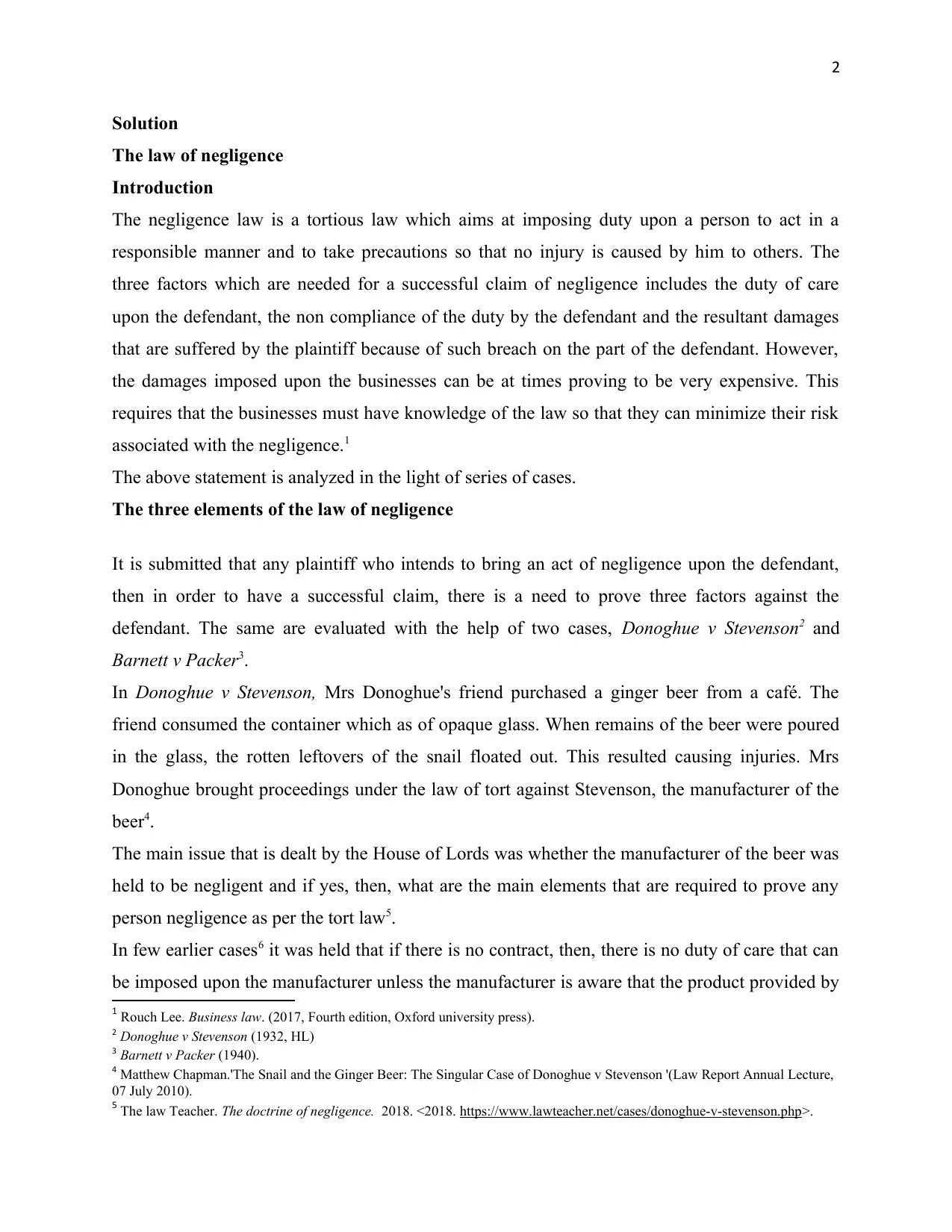
2
Solution
The law of negligence
Introduction
The negligence law is a tortious law which aims at imposing duty upon a person to act in a
responsible manner and to take precautions so that no injury is caused by him to others. The
three factors which are needed for a successful claim of negligence includes the duty of care
upon the defendant, the non compliance of the duty by the defendant and the resultant damages
that are suffered by the plaintiff because of such breach on the part of the defendant. However,
the damages imposed upon the businesses can be at times proving to be very expensive. This
requires that the businesses must have knowledge of the law so that they can minimize their risk
associated with the negligence.1
The above statement is analyzed in the light of series of cases.
The three elements of the law of negligence
It is submitted that any plaintiff who intends to bring an act of negligence upon the defendant,
then in order to have a successful claim, there is a need to prove three factors against the
defendant. The same are evaluated with the help of two cases, Donoghue v Stevenson2 and
Barnett v Packer3.
In Donoghue v Stevenson, Mrs Donoghue's friend purchased a ginger beer from a café. The
friend consumed the container which as of opaque glass. When remains of the beer were poured
in the glass, the rotten leftovers of the snail floated out. This resulted causing injuries. Mrs
Donoghue brought proceedings under the law of tort against Stevenson, the manufacturer of the
beer4.
The main issue that is dealt by the House of Lords was whether the manufacturer of the beer was
held to be negligent and if yes, then, what are the main elements that are required to prove any
person negligence as per the tort law5.
In few earlier cases6 it was held that if there is no contract, then, there is no duty of care that can
be imposed upon the manufacturer unless the manufacturer is aware that the product provided by
1 Rouch Lee. Business law. (2017, Fourth edition, Oxford university press).
2 Donoghue v Stevenson (1932, HL)
3 Barnett v Packer (1940).
4 Matthew Chapman.'The Snail and the Ginger Beer: The Singular Case of Donoghue v Stevenson '(Law Report Annual Lecture,
07 July 2010).
5 The law Teacher. The doctrine of negligence. 2018. <2018. https://www.lawteacher.net/cases/donoghue-v-stevenson.php>.
Solution
The law of negligence
Introduction
The negligence law is a tortious law which aims at imposing duty upon a person to act in a
responsible manner and to take precautions so that no injury is caused by him to others. The
three factors which are needed for a successful claim of negligence includes the duty of care
upon the defendant, the non compliance of the duty by the defendant and the resultant damages
that are suffered by the plaintiff because of such breach on the part of the defendant. However,
the damages imposed upon the businesses can be at times proving to be very expensive. This
requires that the businesses must have knowledge of the law so that they can minimize their risk
associated with the negligence.1
The above statement is analyzed in the light of series of cases.
The three elements of the law of negligence
It is submitted that any plaintiff who intends to bring an act of negligence upon the defendant,
then in order to have a successful claim, there is a need to prove three factors against the
defendant. The same are evaluated with the help of two cases, Donoghue v Stevenson2 and
Barnett v Packer3.
In Donoghue v Stevenson, Mrs Donoghue's friend purchased a ginger beer from a café. The
friend consumed the container which as of opaque glass. When remains of the beer were poured
in the glass, the rotten leftovers of the snail floated out. This resulted causing injuries. Mrs
Donoghue brought proceedings under the law of tort against Stevenson, the manufacturer of the
beer4.
The main issue that is dealt by the House of Lords was whether the manufacturer of the beer was
held to be negligent and if yes, then, what are the main elements that are required to prove any
person negligence as per the tort law5.
In few earlier cases6 it was held that if there is no contract, then, there is no duty of care that can
be imposed upon the manufacturer unless the manufacturer is aware that the product provided by
1 Rouch Lee. Business law. (2017, Fourth edition, Oxford university press).
2 Donoghue v Stevenson (1932, HL)
3 Barnett v Packer (1940).
4 Matthew Chapman.'The Snail and the Ginger Beer: The Singular Case of Donoghue v Stevenson '(Law Report Annual Lecture,
07 July 2010).
5 The law Teacher. The doctrine of negligence. 2018. <2018. https://www.lawteacher.net/cases/donoghue-v-stevenson.php>.
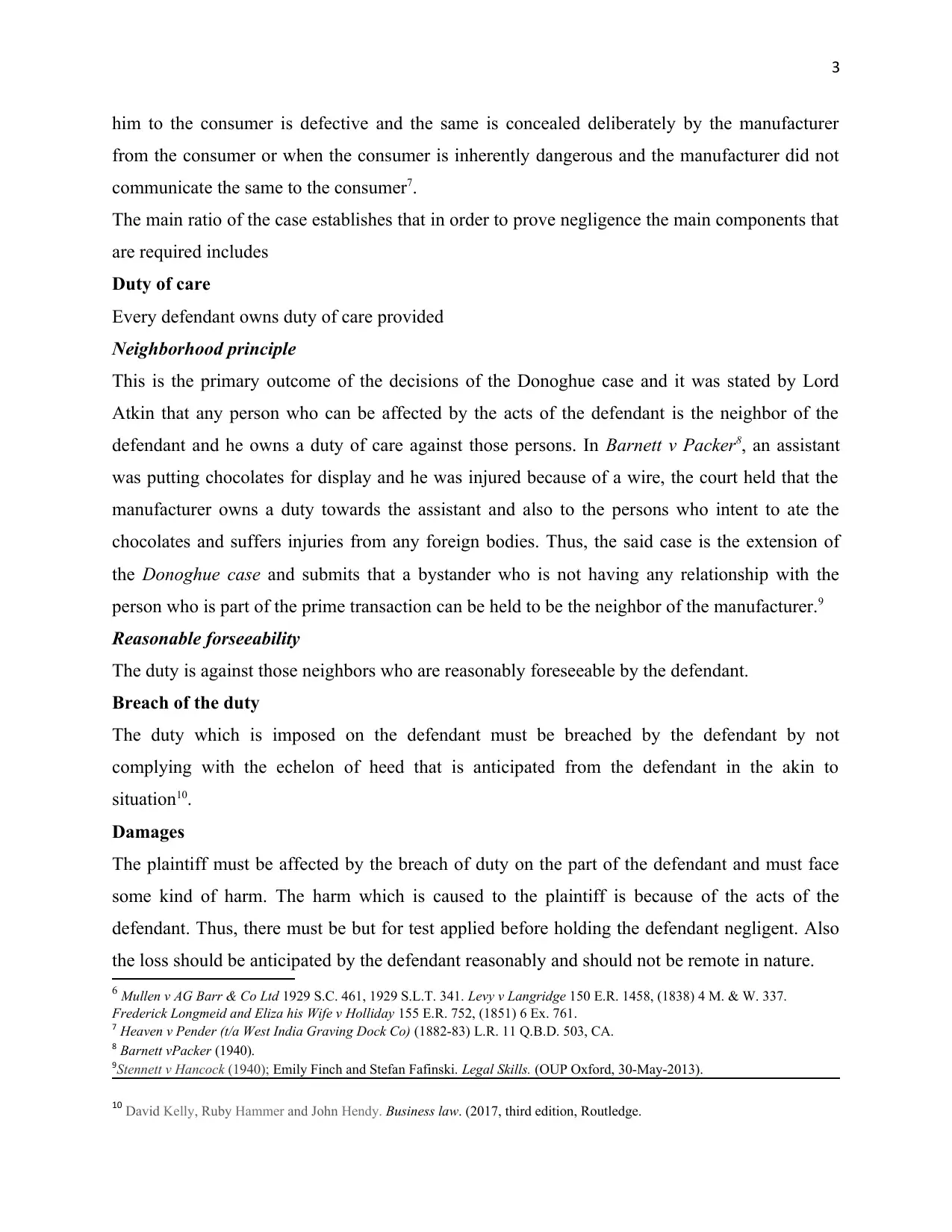
3
him to the consumer is defective and the same is concealed deliberately by the manufacturer
from the consumer or when the consumer is inherently dangerous and the manufacturer did not
communicate the same to the consumer7.
The main ratio of the case establishes that in order to prove negligence the main components that
are required includes
Duty of care
Every defendant owns duty of care provided
Neighborhood principle
This is the primary outcome of the decisions of the Donoghue case and it was stated by Lord
Atkin that any person who can be affected by the acts of the defendant is the neighbor of the
defendant and he owns a duty of care against those persons. In Barnett v Packer8, an assistant
was putting chocolates for display and he was injured because of a wire, the court held that the
manufacturer owns a duty towards the assistant and also to the persons who intent to ate the
chocolates and suffers injuries from any foreign bodies. Thus, the said case is the extension of
the Donoghue case and submits that a bystander who is not having any relationship with the
person who is part of the prime transaction can be held to be the neighbor of the manufacturer.9
Reasonable forseeability
The duty is against those neighbors who are reasonably foreseeable by the defendant.
Breach of the duty
The duty which is imposed on the defendant must be breached by the defendant by not
complying with the echelon of heed that is anticipated from the defendant in the akin to
situation10.
Damages
The plaintiff must be affected by the breach of duty on the part of the defendant and must face
some kind of harm. The harm which is caused to the plaintiff is because of the acts of the
defendant. Thus, there must be but for test applied before holding the defendant negligent. Also
the loss should be anticipated by the defendant reasonably and should not be remote in nature.
6 Mullen v AG Barr & Co Ltd 1929 S.C. 461, 1929 S.L.T. 341. Levy v Langridge 150 E.R. 1458, (1838) 4 M. & W. 337.
Frederick Longmeid and Eliza his Wife v Holliday 155 E.R. 752, (1851) 6 Ex. 761.
7 Heaven v Pender (t/a West India Graving Dock Co) (1882-83) L.R. 11 Q.B.D. 503, CA.
8 Barnett vPacker (1940).
9Stennett v Hancock (1940); Emily Finch and Stefan Fafinski. Legal Skills. (OUP Oxford, 30-May-2013).
10 David Kelly, Ruby Hammer and John Hendy. Business law. (2017, third edition, Routledge.
him to the consumer is defective and the same is concealed deliberately by the manufacturer
from the consumer or when the consumer is inherently dangerous and the manufacturer did not
communicate the same to the consumer7.
The main ratio of the case establishes that in order to prove negligence the main components that
are required includes
Duty of care
Every defendant owns duty of care provided
Neighborhood principle
This is the primary outcome of the decisions of the Donoghue case and it was stated by Lord
Atkin that any person who can be affected by the acts of the defendant is the neighbor of the
defendant and he owns a duty of care against those persons. In Barnett v Packer8, an assistant
was putting chocolates for display and he was injured because of a wire, the court held that the
manufacturer owns a duty towards the assistant and also to the persons who intent to ate the
chocolates and suffers injuries from any foreign bodies. Thus, the said case is the extension of
the Donoghue case and submits that a bystander who is not having any relationship with the
person who is part of the prime transaction can be held to be the neighbor of the manufacturer.9
Reasonable forseeability
The duty is against those neighbors who are reasonably foreseeable by the defendant.
Breach of the duty
The duty which is imposed on the defendant must be breached by the defendant by not
complying with the echelon of heed that is anticipated from the defendant in the akin to
situation10.
Damages
The plaintiff must be affected by the breach of duty on the part of the defendant and must face
some kind of harm. The harm which is caused to the plaintiff is because of the acts of the
defendant. Thus, there must be but for test applied before holding the defendant negligent. Also
the loss should be anticipated by the defendant reasonably and should not be remote in nature.
6 Mullen v AG Barr & Co Ltd 1929 S.C. 461, 1929 S.L.T. 341. Levy v Langridge 150 E.R. 1458, (1838) 4 M. & W. 337.
Frederick Longmeid and Eliza his Wife v Holliday 155 E.R. 752, (1851) 6 Ex. 761.
7 Heaven v Pender (t/a West India Graving Dock Co) (1882-83) L.R. 11 Q.B.D. 503, CA.
8 Barnett vPacker (1940).
9Stennett v Hancock (1940); Emily Finch and Stefan Fafinski. Legal Skills. (OUP Oxford, 30-May-2013).
10 David Kelly, Ruby Hammer and John Hendy. Business law. (2017, third edition, Routledge.
⊘ This is a preview!⊘
Do you want full access?
Subscribe today to unlock all pages.

Trusted by 1+ million students worldwide

4
Now, t is stated that the main aim of holding any defendant negligent is that damages must be
paid to the injured party so that he must be placed at the position considering he has suffered no
loss. But, this compensation of loss by the defendant business can be hold to be very expensive.
Lack of quality in the goods does not in itself give rise to negligence liability.
The lack of quality in the goods does not in itself give rise to negligence liability.
In Junior Books Ltd v Veitchi Co Ltd11, the defendants were the experts in the flooring and were
the sub contractors in a factory to lay the floor. The factory is to be used by the plaintiff. The
plaintiff argued that the defendant has lay the floor which was faulty and thus must be considered
as negligent considering the fact that they are specialist in the tasks. The plaintiff held that the
floor cracked and thus the same was faulty so, the defendant must be held to be negligent. The
plaintiff suffers loss and thus sought the cost that is incurred for laying the floor, loss of profits
and the cost of the replacement of the floor.12
It is important to submit that because of the faulty floor there was no injury that was caused to
any person including plaintiff. At this stage is it right to submit that the lack in the quality of the
product results in bringing a claim by the plaintiff under the law of negligence.
The court held that the relationship that is shared by the parties is such that it inflicts duty of care
upon the defendant to be catered with towards the faulty floor. The court enlarged its scope and
the area of the law of negligence and held that the duty of care that is imposed on the defendant
is not only towards the reasonable foreseeable persons or property but the duty is extended to
avoid any kind of pure economic loss that can be suffered by the plaintiffs because of the breach
of duty on the part of the defendant.
Thus, the lack of quality in the goods does not in itself give rise to negligence liability rather
there must be duty on the defendant to avoid pure economic loss that can be suffered by the
plaintiff.
Later in Muirhead v Industrial Tank Specialities Ltd13, the plaintiffs were the merchants of the
fish and they employed defendants (manufacturers of the tank) so that they can supply the tanks
11 Junior Books Ltd v Veitchi Co Ltd [1983] 1 AC 520.
12 Lucy Jones. Introduction to Business Law. (2017, Fourth edition, Oxford University press).
13 Muirhead v Industrial Tank Specialities Ltd (1986) .
Now, t is stated that the main aim of holding any defendant negligent is that damages must be
paid to the injured party so that he must be placed at the position considering he has suffered no
loss. But, this compensation of loss by the defendant business can be hold to be very expensive.
Lack of quality in the goods does not in itself give rise to negligence liability.
The lack of quality in the goods does not in itself give rise to negligence liability.
In Junior Books Ltd v Veitchi Co Ltd11, the defendants were the experts in the flooring and were
the sub contractors in a factory to lay the floor. The factory is to be used by the plaintiff. The
plaintiff argued that the defendant has lay the floor which was faulty and thus must be considered
as negligent considering the fact that they are specialist in the tasks. The plaintiff held that the
floor cracked and thus the same was faulty so, the defendant must be held to be negligent. The
plaintiff suffers loss and thus sought the cost that is incurred for laying the floor, loss of profits
and the cost of the replacement of the floor.12
It is important to submit that because of the faulty floor there was no injury that was caused to
any person including plaintiff. At this stage is it right to submit that the lack in the quality of the
product results in bringing a claim by the plaintiff under the law of negligence.
The court held that the relationship that is shared by the parties is such that it inflicts duty of care
upon the defendant to be catered with towards the faulty floor. The court enlarged its scope and
the area of the law of negligence and held that the duty of care that is imposed on the defendant
is not only towards the reasonable foreseeable persons or property but the duty is extended to
avoid any kind of pure economic loss that can be suffered by the plaintiffs because of the breach
of duty on the part of the defendant.
Thus, the lack of quality in the goods does not in itself give rise to negligence liability rather
there must be duty on the defendant to avoid pure economic loss that can be suffered by the
plaintiff.
Later in Muirhead v Industrial Tank Specialities Ltd13, the plaintiffs were the merchants of the
fish and they employed defendants (manufacturers of the tank) so that they can supply the tanks
11 Junior Books Ltd v Veitchi Co Ltd [1983] 1 AC 520.
12 Lucy Jones. Introduction to Business Law. (2017, Fourth edition, Oxford University press).
13 Muirhead v Industrial Tank Specialities Ltd (1986) .
Paraphrase This Document
Need a fresh take? Get an instant paraphrase of this document with our AI Paraphraser
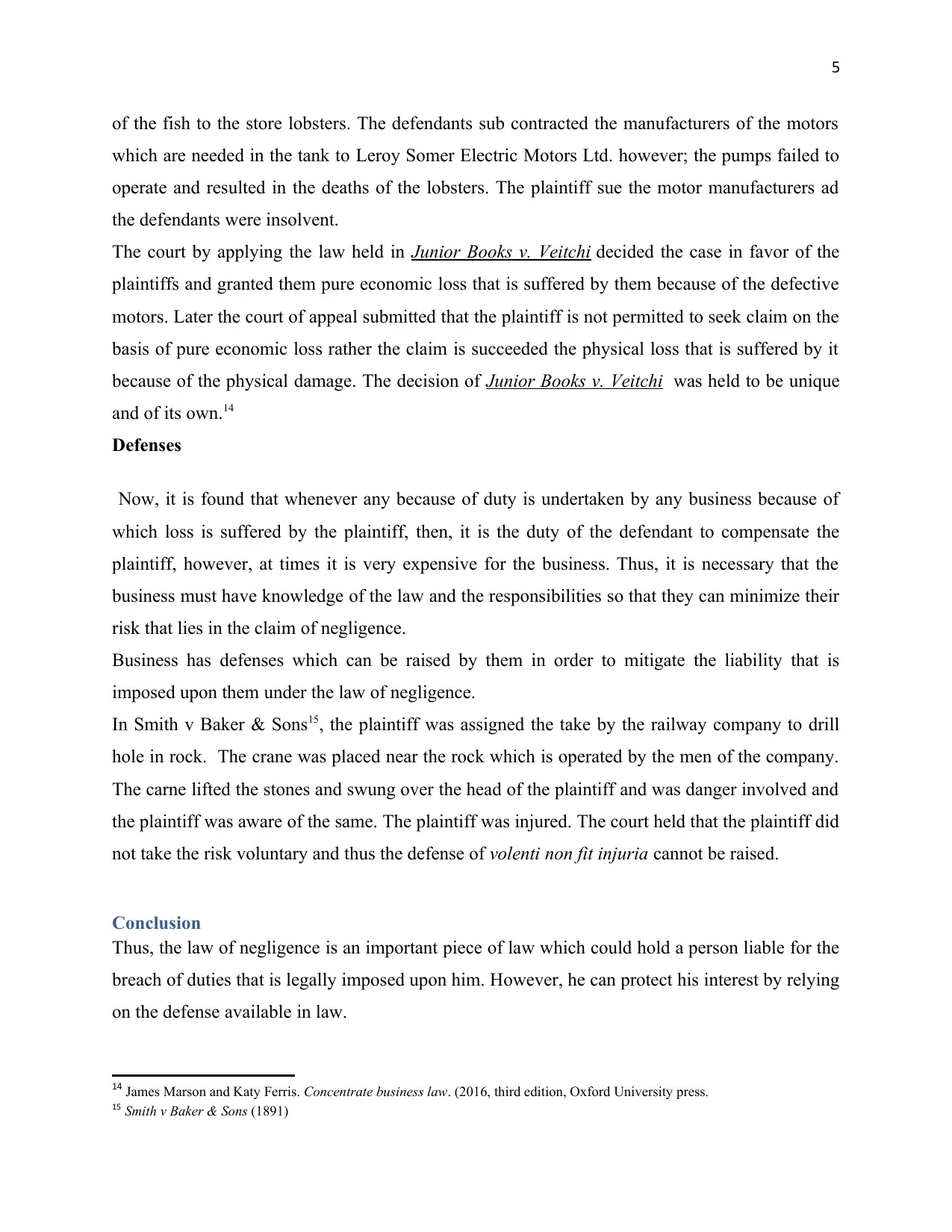
5
of the fish to the store lobsters. The defendants sub contracted the manufacturers of the motors
which are needed in the tank to Leroy Somer Electric Motors Ltd. however; the pumps failed to
operate and resulted in the deaths of the lobsters. The plaintiff sue the motor manufacturers ad
the defendants were insolvent.
The court by applying the law held in Junior Books v. Veitchi decided the case in favor of the
plaintiffs and granted them pure economic loss that is suffered by them because of the defective
motors. Later the court of appeal submitted that the plaintiff is not permitted to seek claim on the
basis of pure economic loss rather the claim is succeeded the physical loss that is suffered by it
because of the physical damage. The decision of Junior Books v. Veitchi was held to be unique
and of its own.14
Defenses
Now, it is found that whenever any because of duty is undertaken by any business because of
which loss is suffered by the plaintiff, then, it is the duty of the defendant to compensate the
plaintiff, however, at times it is very expensive for the business. Thus, it is necessary that the
business must have knowledge of the law and the responsibilities so that they can minimize their
risk that lies in the claim of negligence.
Business has defenses which can be raised by them in order to mitigate the liability that is
imposed upon them under the law of negligence.
In Smith v Baker & Sons15, the plaintiff was assigned the take by the railway company to drill
hole in rock. The crane was placed near the rock which is operated by the men of the company.
The carne lifted the stones and swung over the head of the plaintiff and was danger involved and
the plaintiff was aware of the same. The plaintiff was injured. The court held that the plaintiff did
not take the risk voluntary and thus the defense of volenti non fit injuria cannot be raised.
Conclusion
Thus, the law of negligence is an important piece of law which could hold a person liable for the
breach of duties that is legally imposed upon him. However, he can protect his interest by relying
on the defense available in law.
14 James Marson and Katy Ferris. Concentrate business law. (2016, third edition, Oxford University press.
15 Smith v Baker & Sons (1891)
of the fish to the store lobsters. The defendants sub contracted the manufacturers of the motors
which are needed in the tank to Leroy Somer Electric Motors Ltd. however; the pumps failed to
operate and resulted in the deaths of the lobsters. The plaintiff sue the motor manufacturers ad
the defendants were insolvent.
The court by applying the law held in Junior Books v. Veitchi decided the case in favor of the
plaintiffs and granted them pure economic loss that is suffered by them because of the defective
motors. Later the court of appeal submitted that the plaintiff is not permitted to seek claim on the
basis of pure economic loss rather the claim is succeeded the physical loss that is suffered by it
because of the physical damage. The decision of Junior Books v. Veitchi was held to be unique
and of its own.14
Defenses
Now, it is found that whenever any because of duty is undertaken by any business because of
which loss is suffered by the plaintiff, then, it is the duty of the defendant to compensate the
plaintiff, however, at times it is very expensive for the business. Thus, it is necessary that the
business must have knowledge of the law and the responsibilities so that they can minimize their
risk that lies in the claim of negligence.
Business has defenses which can be raised by them in order to mitigate the liability that is
imposed upon them under the law of negligence.
In Smith v Baker & Sons15, the plaintiff was assigned the take by the railway company to drill
hole in rock. The crane was placed near the rock which is operated by the men of the company.
The carne lifted the stones and swung over the head of the plaintiff and was danger involved and
the plaintiff was aware of the same. The plaintiff was injured. The court held that the plaintiff did
not take the risk voluntary and thus the defense of volenti non fit injuria cannot be raised.
Conclusion
Thus, the law of negligence is an important piece of law which could hold a person liable for the
breach of duties that is legally imposed upon him. However, he can protect his interest by relying
on the defense available in law.
14 James Marson and Katy Ferris. Concentrate business law. (2016, third edition, Oxford University press.
15 Smith v Baker & Sons (1891)
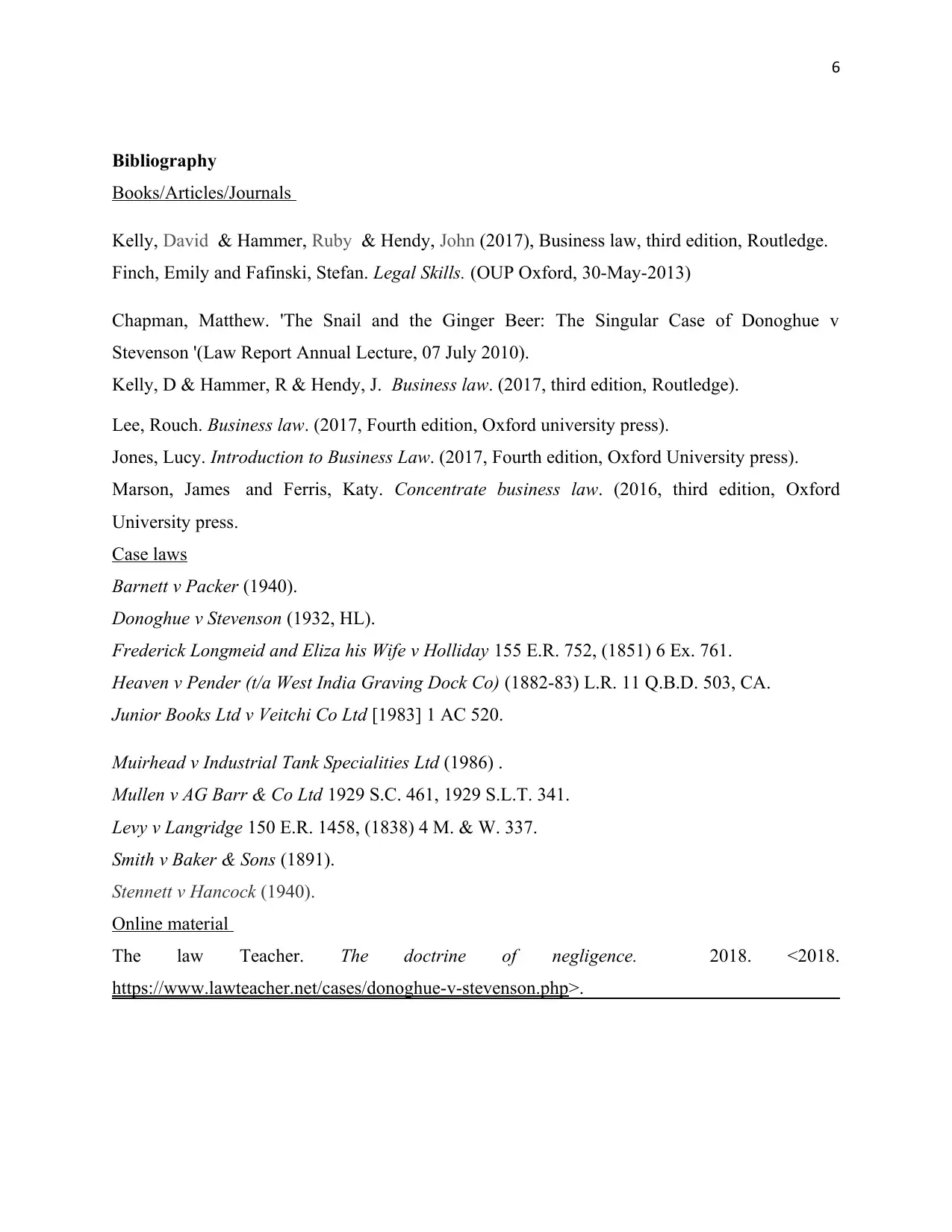
6
Bibliography
Books/Articles/Journals
Kelly, David & Hammer, Ruby & Hendy, John (2017), Business law, third edition, Routledge.
Finch, Emily and Fafinski, Stefan. Legal Skills. (OUP Oxford, 30-May-2013)
Chapman, Matthew. 'The Snail and the Ginger Beer: The Singular Case of Donoghue v
Stevenson '(Law Report Annual Lecture, 07 July 2010).
Kelly, D & Hammer, R & Hendy, J. Business law. (2017, third edition, Routledge).
Lee, Rouch. Business law. (2017, Fourth edition, Oxford university press).
Jones, Lucy. Introduction to Business Law. (2017, Fourth edition, Oxford University press).
Marson, James and Ferris, Katy. Concentrate business law. (2016, third edition, Oxford
University press.
Case laws
Barnett v Packer (1940).
Donoghue v Stevenson (1932, HL).
Frederick Longmeid and Eliza his Wife v Holliday 155 E.R. 752, (1851) 6 Ex. 761.
Heaven v Pender (t/a West India Graving Dock Co) (1882-83) L.R. 11 Q.B.D. 503, CA.
Junior Books Ltd v Veitchi Co Ltd [1983] 1 AC 520.
Muirhead v Industrial Tank Specialities Ltd (1986) .
Mullen v AG Barr & Co Ltd 1929 S.C. 461, 1929 S.L.T. 341.
Levy v Langridge 150 E.R. 1458, (1838) 4 M. & W. 337.
Smith v Baker & Sons (1891).
Stennett v Hancock (1940).
Online material
The law Teacher. The doctrine of negligence. 2018. <2018.
https://www.lawteacher.net/cases/donoghue-v-stevenson.php>.
Bibliography
Books/Articles/Journals
Kelly, David & Hammer, Ruby & Hendy, John (2017), Business law, third edition, Routledge.
Finch, Emily and Fafinski, Stefan. Legal Skills. (OUP Oxford, 30-May-2013)
Chapman, Matthew. 'The Snail and the Ginger Beer: The Singular Case of Donoghue v
Stevenson '(Law Report Annual Lecture, 07 July 2010).
Kelly, D & Hammer, R & Hendy, J. Business law. (2017, third edition, Routledge).
Lee, Rouch. Business law. (2017, Fourth edition, Oxford university press).
Jones, Lucy. Introduction to Business Law. (2017, Fourth edition, Oxford University press).
Marson, James and Ferris, Katy. Concentrate business law. (2016, third edition, Oxford
University press.
Case laws
Barnett v Packer (1940).
Donoghue v Stevenson (1932, HL).
Frederick Longmeid and Eliza his Wife v Holliday 155 E.R. 752, (1851) 6 Ex. 761.
Heaven v Pender (t/a West India Graving Dock Co) (1882-83) L.R. 11 Q.B.D. 503, CA.
Junior Books Ltd v Veitchi Co Ltd [1983] 1 AC 520.
Muirhead v Industrial Tank Specialities Ltd (1986) .
Mullen v AG Barr & Co Ltd 1929 S.C. 461, 1929 S.L.T. 341.
Levy v Langridge 150 E.R. 1458, (1838) 4 M. & W. 337.
Smith v Baker & Sons (1891).
Stennett v Hancock (1940).
Online material
The law Teacher. The doctrine of negligence. 2018. <2018.
https://www.lawteacher.net/cases/donoghue-v-stevenson.php>.
⊘ This is a preview!⊘
Do you want full access?
Subscribe today to unlock all pages.

Trusted by 1+ million students worldwide
1 out of 6
Related Documents
Your All-in-One AI-Powered Toolkit for Academic Success.
+13062052269
info@desklib.com
Available 24*7 on WhatsApp / Email
![[object Object]](/_next/static/media/star-bottom.7253800d.svg)
Unlock your academic potential
Copyright © 2020–2025 A2Z Services. All Rights Reserved. Developed and managed by ZUCOL.





